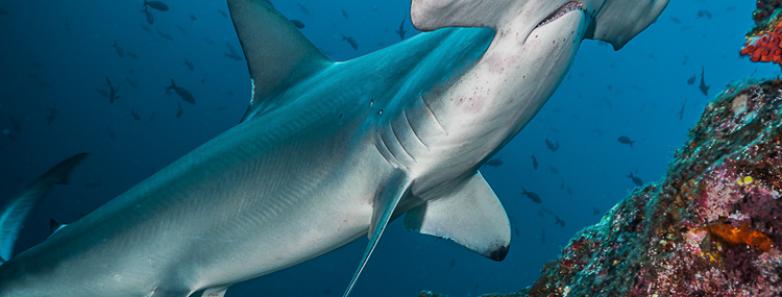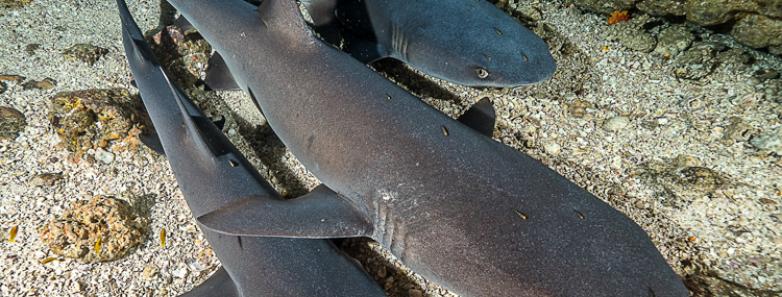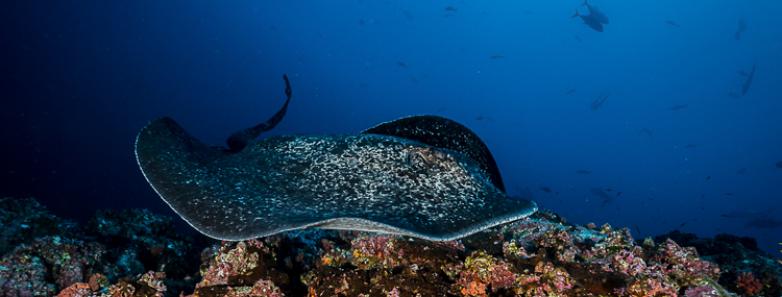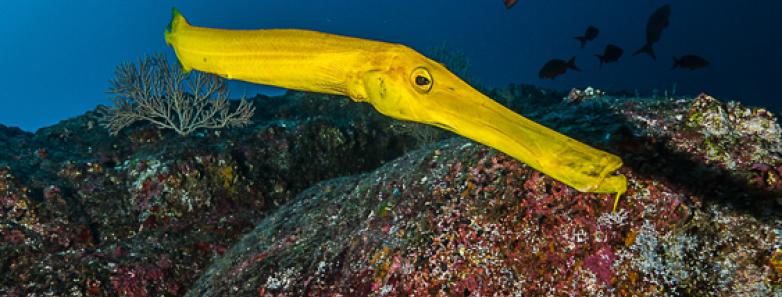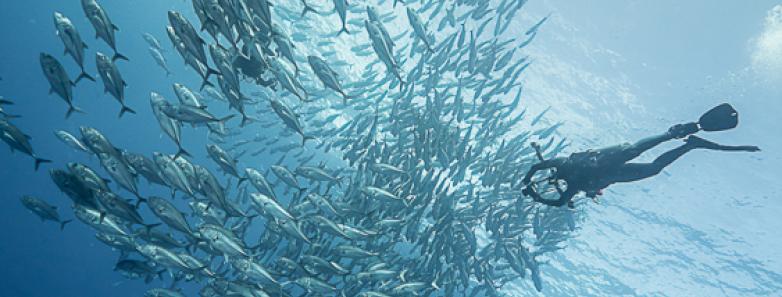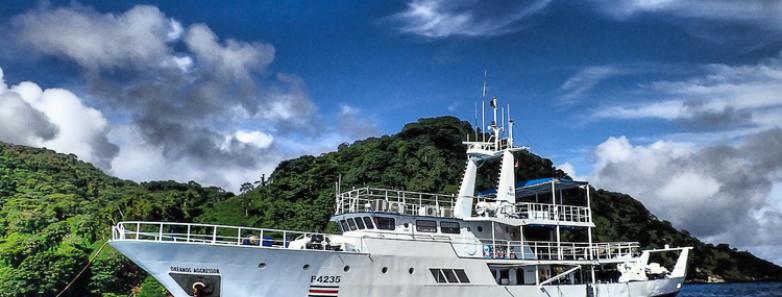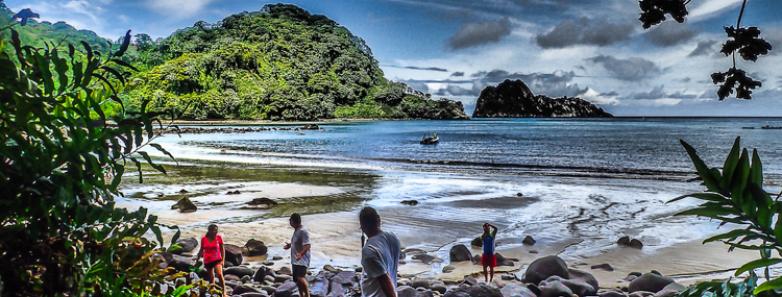Scuba diving Costa Rica
Scuba diving Costa Rica offers unique opportunities for divers of all experience levels. Both above and below the water, Costa Rica, translated as ‘rich coast’ in Spanish, is known for its lush tropical forests and abundant wildlife. Located in Central America, the country occupies a narrow strip of volcanic land squeezed between the Pacific Ocean and the southern Caribbean Sea. The region’s tropical climate and variety of habitats encourage some of the richest biodiversity in the world, including several rare and endangered species.
On Costa Rica’s west coast, nutrient-rich upwellings and Pacific Ocean currents entice big pelagic fish and mammals close to the shore, with islands such as the Catalinas and the Bat Islands offering some exciting day-trip opportunities for Costa Rica scuba diving. Also, 340 miles further offshore, Costa Rica’s flagship dive location, Cocos Island, is known globally as a fantastic hammerhead shark destination.
On the east coast, vibrant Caribbean reefs hide protected sites that are yet to be fully explored. A relaxing alternative to the west coast’s big ocean diving, Costa Rica’s Caribbean sites offer a plethora of tropical marine life and are perfect for beginners and snorkelers.
Jump to:
Costa Rica Dive Areas - How to Dive Costa Rica
The Best Places for COSTA RICA scuba diving
Here are some of the best places to dive in Costa Rica.
1. COCOS ISLAND
On par with the Galapagos and Socorro Islands, remote Cocos Island National Park is a UNESCO World Heritage Centre and a mecca for all things sharky. Diving here typically wouldn’t be described as pretty, as there is virtually no colorful coral and therefore none of the associated vibrant reef species. But don’t be fooled - the waters around Cocos are some of the richest in the world. Pacific Ocean currents converge to bring all manner of shark species and a myriad of other pelagics to the island. Huge walls of schooling hammerheads are the big-ticket attraction here, with divers traveling from all over to photograph them in their hundreds.
Find out more about diving Cocos Island.
2. CATALINA ISLANDS
Situated midway along Costa Rica’s Pacific Coast, the Catalina Islands lie between two and 15 miles offshore and are one of the most popular locations for scuba diving in Costa Rica. These rocky volcanic outcrops sport crystal clear waters and some fascinating underwater topography. Large caves and natural arches covered in bright corals are home to a variety of marine life including turtles, reef sharks, and dozens of rays, including mobula, devil, and the massive Pacific manta ray. Scuba diving Catalina Islands is an exciting introduction to Costa Rica's Pacific coast.
3. BAT ISLANDS
A marine protected area, the Bat Islands are located off the very northwest coast of Costa Rica and are around a 50-minute boat ride from the mainland. Divers will find vast shoals of many different fish species, as well as schooling devil rays, manta rays, and the huge bull sharks that the islands are famed for. The best-known site for scuba diving Bat Islands is Big Scare, where bull sharks as big as 23ft have been known to cruise the outermost island’s steep walls. Strong currents and depths over 100ft mean this Bat Island dive site is not for the faint-hearted.
4. TORTUGA ISLANDS
Located off the southeastern edge of the Nicoya Peninsula, this small group of protected islands boasts a diversity of dive sites including some fascinating underwater formations at Canones (Canyons) and El Laberinto (The Labyrinth), exciting drift diving at Bye Bye Reef, and three wrecks all within recreational limits. The Franklin Chang Diaz and Colonel Alfonso Mong were both Coastguard ships that are easily accessible to divers of all abilities, while the Caroline Star sits in 98ft of water and is home to a good number of reef sharks. The waters around Tortuga are full of life and perfect for snorkelers and novice divers looking to explore scuba diving in Costa Rica.
5. CANO ISLAND
Costa Rica’s southern Osa Peninsula boasts some unique diving spots around the Cano Island Biological Reserve. The area’s protected status means there are only five official Cani Island dive locations, allowing 10 divers in the water at any one time. El Bajo del Diablo (Devil’s Rock) is a great spot to catch a glimpse of manta rays, bull sharks, and nurse sharks between the site’s huge rocky pinnacles, peaks, and canyons. Paraiso (Paradise) is a volcanic lava formation where blue and gold snappers congregate in their thousands, watched by circling barracuda looking for their next meal. Scuba diving Cano Island is a unique experience not to be missed.
6. TAMARINDO
Located on Costa Rica's northern Pacific Coast, Tamarindo offers access to a wealth of interesting dive sites along the Nicoya Peninsula. The town is a livley beach resort with plenty of hotels and restaurants, and is the main departure point for diving the Catalina Islands and Bat Islands. There are plenty of operators offering year-round day trips to explore some of the best diving in Costa Rica.
7. GANDOCA MANZANILLO WILDLIFE REFUGE
The best area for snorkeling and scuba diving Costa Rica’s Caribbean coastline, this region’s tropical bays and lagoons offer a sheltered refuge for turtles, manatees, crocodiles, and dolphins. There is a plethora of small tropical fish here, and the shallow sites and warm clear water offer relaxing diving at uncrowded sites.
HOW TO scuba DIVE COSTA RICA
Costa Rica is a great eco-tourism destination and the country’s west coast is home to several popular resort areas. Many of the inshore Pacific dive sites can be reached by day-trip boats from towns such as Tamarindo, Playa Potrero, Jaco, and Puntarenas. The country’s east coast is less developed, and visitors will find relaxed hideaways and unspoiled beaches. However, this goes hand-in-hand with a less established dive infrastructure, and some planning is required for diving these frontier sites.
Cocos Island is a liveaboard-only destination, with most boats offering 10-night trips departing year-round from Puntarenas. Shorter trips to Cocos are not possible because the crossing takes about 40 hours depending on the weather.
Costa Rica scuba diving is split between the rainy season from May to November, and the dry season from December to April. During the rainy season, a couple hours of rainfall each day is the norm - however, the water tends to be warmer and have better visibility. The Pacific Coast experiences very little rainfall during the dry season, but this is peak tourist time so resorts and activities will be busier and more expensive than in the rainy months. August to December is the best time to visit the Southern Caribbean Coast when seas are calmer and there is little wind.
When to visit also depends on what you want to see. The rainy season is the best time to encounter sharks at Cocos Island and around the Bat Islands, however cooler oceanic currents during the dry season bring many of the other big pelagic species close into shore.
Cocos enjoys a similar climate to mainland Costa Rica, with smoother crossings during the dry season when seas are calmer. June and July are ideal months to visit as the seas are likely to still be calm and the big pelagic species have started to arrive in larger numbers.
costa rica scuba Diving Conditions
- Water temperature: Pacific Coast and Caribbean 78-85°F (26-29°C), Cocos 78-82°F (26-27°F) wet season, 70°F (21°C) dry season. Can drop to low 60s (15°C) at depth.
- Visibility: Pacific Coast and Caribbean 50-100ft (15-30m), Cocos 30-50ft (9-15m).
- Depth Range: Pacific Coast 30-131ft (10-40m), Caribbean 5-131ft (5-131ft) Cocos 30-131ft (10-40m).
- Diving Difficulty: Pacific Coast suitable for intermediate levels, Caribbean suitable for all levels including snorkelers, Cocos best for advanced divers.
costa rica MARINE LIFE & PHOTOGRAPHY SUBJECTS
Scuba diving in Costa Rica offeres the opportunity for some incredible marine life encounters and underwater photography opportunities. While hammerhead sharks are the big-ticket attraction at Cocos Island, divers can expect to spot many other shark species such as Galapagos, silky, silvertip, and whitetip reef sharks. Whale shark and manta sightings are common, and lucky visitors might spot the occasional tiger shark. Other regular sightings include tuna, wahoo, jack, and dolphins, and there are also endemic fish, such as the red-lipped batfish, to find.
Big pelagic species are also a common sight along Costa Rica’s Pacific coastline, with huge schools of eagles rays, mobula rays, and manta rays feeding on plankton blooms during the rainy season. From January until March, and again in June and July, humpback whales migrate through the region, and they can be seen from the surface or heard underwater.
On the east coast, healthy coral reefs are home to a year-round abundance of tropical fish, as well as hawksbill and loggerhead turtles, saltwater crocodiles, and the elusive manatee.
costa rica Travel Information
HOW TO GET TO COSTA RICA
Costa Rica is easily accessed from the US via two international airports: Juan Santamaria International Airport (SJO) and Daniel Oduber Quiros International Airport (LIR). Most flights arrive at the former, and this is the airport to use for trips to Cocos Island. There are also some direct flights from Europe.
OTHER THINGS TO DO IN COSTA RICA
Costa Rica is one of the top nature destinations in the world. There are excellent opportunities to see monkeys, toucans, brilliantly colored tree frogs, parrots, sloths, and many other birds and animals. Adrenaline junkies can take part in white-water rafting or surfing, and the country’s volcanoes feed relaxing hot springs and act as amazing motivation for tourists to take scenic hikes. Costa Rica is small, easy to travel around, and relatively safe.
For another unique wildlife destination, read our guide to scuba diving Komodo, and meeting the Komodo Dragons.
Other Useful Information
costa rica Practical Information
- Currency: Costa Rican Colón (CRC)
- Language: Spanish, but English is widely spoken
- Time Zone: UTC-6
- Electricity: 120V
GOT QUESTIONS? READY TO BOOK?
Call us today at 310-915-6677 or email us bookings@bluewaterdivetravel.com
And let us book your dream vacation!

